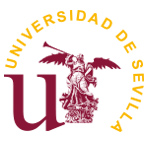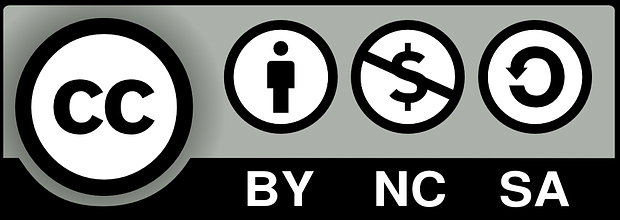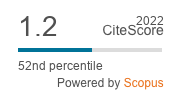Questionnaire on knowledge of university mathematics teachers for technological integration
DOI:
https://doi.org/10.12795/revistafuentes.2021.12792Keywords:
Higher Education, Mathematics, Questionnaires, Information Technology, Teachers, Educational technology, Teacher qualifications, KnowledgeAbstract
The aim of this research is to develop a self-evaluation questionnaire to measure the knowledge of university mathematics teachers about technological integration in the classroom. The TPACK model is recognized by the scientific community to describe teachers' understanding of the complex interaction between content, pedagogy and technology. The Schmidt et al. (2009) questionnaire is adapted to the field of Mathematics. The questionnaire is made up of 28 items and is assessed using a scale of four levels (1: never; 4: always). The sample was 183 university teachers of Mathematics. The analysis of structural equation models was used to examine the factors of the TPACK model. The results confirm the seven factors model and indicate that the TPACK perceived by teachers correlates positively with all other factors. Finally, it is concluded that the instrument is valid and reliable.
Downloads
References
Agyei, D. D., y Voogt, J. M. (2015). Pre-service teachers’ TPACK competencies for spreadsheet integration: insights from a mathematics-specific instructional technology course. Technology, Pedagogy and Education, 24(5), 605-625. Retrieved from https://dx.doi.org/10.1080/1475939x.2015.1096822 10.1080/1475939x.2015 .1096822
Alhashem, F., Alrwaished, N., y Alkandari, A. (2017). Exploring In- and Pre-Service Science and Mathematics Teachers’ Technology, Pedagogy, and Content Knowledge (TPACK): What Next? EURASIA Journal of Mathematics, Science and Technology Education, 13(9), 6113-6131. Retrieved from https://dx.doi.org/10 .12973/eurasia.2017.01053a 10.12973/eurasia.2017.01053a
Baser, D., Kopcha, T. J., y Ozden, M. Y. (2016). Developing a technological pedagogical content knowledge (TPACK) assessment for preservice teachers learning to teach English as a foreign language. Computer Assisted Language Learning, 29(4), 749-764. Retrieved from https://dx.doi.org/10.1080/09588221.2015 .1047456 10.1080/09588221.2015.1047456
Bilici, S. C., Yamak, H., Kavak, N., y Guzey, S. S. (2013). Technological pedagogical content knowledge self- efficacy scale (TPACK-SeS) for pre-service science teachers: Construction, validation, and reliability. Eurasian Journal of Educational Research, 13(52), 37-60.
Chai, C. S., Koh, J. H. L., y Tsai, C. C. (2010). Facilitating preservice teacher’s development of TPACK. Journal of Educational Technology & Society, 13(4), 63-73.
Chai, C. S., Koh, J. H. L., y Tsai, C. C. (2013). A review of technological pedagogical content knowledge. Journal of Educational Technology & Society, 16(2), 31-51.
Chai, C. S., Koh, J. H. L., y Tsai, C. C. (2016). A review of the quantitative measures of technological pedagogical content knowledge (TPACK). In M. C. Herring, M. J. Koehler, y P. Mishra (Eds.), Handbook of Technological Pedagogical Content Knowledge (TPACK) for Educators (Second Edition ed., p. 87-106). Routledge. Retrieved from https://doi:10.4324/9781315771328 https://doi:10.4324/9781315771328
Cubeles, A., y Riu, D. (2018). The effective integration of ICTs in universities: the role of knowledge and academic experience of professors. Technology, Pedagogy and Education, 27(3), 339-349. Retrieved from https://dx.doi.org/10.1080/1475939x.2018.1457978 10.1080/1475939x.2018.1457978
Fan, J., Peng, L., Li, K. H., y Tan, C. S. (2012). Wafer-level hermetic packaging of 3D microsystems with low-temperature Cu-to-Cu thermo-compression bonding and its reliability. Journal of Micromechanics and Microengineering, 22, 105004-105004. Retrieved from https://dx.doi.org/10.1088/0960-1317/22/10/105004 10.1088/0960-1317/22/10/105004
Finger, G., Romeo, G., Lloyd, M., Heck, D., Sweeney, T., Albion, P., y Jamieson-Proctor, R. (2015). Developing Graduate TPACK Capabilities in Initial Teacher Education Programs: Insights from the Teaching Teachers for the Future Project. The Asia-Pacific Education Researcher, 24(3), 505-513. Retrieved from https://dx.doi.org/ 10.1007/s40299-014-0226-x 10.1007/s40299-014-0226-x
Giaconi, V., Perdomo-Díaz, J., Cerda, G., y Saadati, F. (2018). Prácticas docentes, autoeficacia y valor en relación con la resolución de problemas de matemáticas: diseño y validación de un cuestionario. Enseñanza de Las Ciencias. Revista de Investigación Y Experiencias Didácticas, 36(3), 99-99.
Graham, C. R., Burgoyne, N., Cantrell, P., Smith, L., St, C., Harris, L., y R. (2009). TPACK development in science teaching: Measuring the TPACK confidence of inservice science teachers. TechTrends, 53(5), 70-79. https://doi.org/10.1007/s11528-009-0328-0
Jang, S.-J., y Tsai, M.-F. (2012). Exploring the TPACK of Taiwanese elementary mathematics and science teachers with respect to use of interactive whiteboards. Computers & Education, 59(2), 327-338. Retrieved from https://dx.doi.org/10.1016/j.compedu.2012.02.003 10.1016/j.compedu.2012.02.003
Kaya, S., y Daǧ, F. (2013). Turkish adaptation of Technological Pedagogical Content Knowledge survey for elementary teachers. Educational Sciences: Theory & Practice, 13, 302-306.
Kline, R. B. (2015). Principles and practice of structural equation modeling. New York, NY, USA: The Guilford Press.
Koehler, M. J., y Mishra, P. (2005). What Happens When Teachers Design Educational Technology? The Development of Technological Pedagogical Content Knowledge. Journal of Educational Computing Research, 32(2), 131-152. Retrieved from https://dx.doi.org/10.2190/0ew7-01wb-bkhl-qdyv 10.2190/0ew7-01wb-bkhl-qdyv Koehler, M. J., Mishra, P., Kereluik, K., Shin, T. S., y Graham, C. R. (2014). The technological pedagogical content knowledge famework. In J. M. Spector, M. D. Merrill, J. Elen, y M. J. Bishop (Eds.), Handbook of Research on Educational Communications and Technology (p. 101-111). Springer. https://doi:10.1007/ 978-1-4614-3185-5
Koh, J. H. L. H. L., Chai, C. S. S., y Tsai, C. C. C. (2010). Examining the technological pedagogical content knowledge of Singapore pre-service teachers with a large-scale survey. Journal of Computer Assisted Learning, 26(6), 563-573.
Lin, T. C., Tsai, C. C., Chai, C. S., y Lee, M. H. (2013). Identifying science teachers’ perceptions of Technological Pedagogical and Content Knowledge (TPACK). Journal of Science Education and Technology, 22(3), 325-336. MISHRA, P., y KOEHLER, M. J. (2006). Technological Pedagogical Content Knowledge: A Framework for Teacher Knowledge. Teachers College Record, 108(6), 1017-1054. Retrieved from https://dx.doi.org/10.1111/ j.1467-9620.2006.00684.x 10.1111/j.1467-9620.2006.00684.x
Niess, M. L. (2011). Investigating TPACK: Knowledge Growth in Teaching with Technology. Journal of Educational Computing Research, 44(3), 299-317. Retrieved from https://dx.doi.org/10.2190/ec.44.3.c 10 .2190/ec.44.3.c
Reyes, V. C., Reading, C., Doyle, H., y Gregory, S. (2017). Integrating ICT into teacher education programs from a TPACK perspective: Exploring perceptions of university lecturers. Computers & Education, 115, 1-19. Retrieved from https://dx.doi.org/10.1016/j.compedu.2017.07.009 10.1016/j.compedu.2017.07.009
Sahin, I. (2011). Development of Survey of Technological Pedagogical and Content Knowledge (TPACK). Turkish Online Journal of Educational Technology - TOJET, 10(1), 97-105.
Schmidt, D., Baran, E., Thompson, A., Mishra, P., Koehler, M., y Shin, T. (2009). Technological pedagogical content knowledge (TPACK): The development and validation of an assessment instrument for preservice teachers. Journal of Research on Technology in Education, 42(2), 123-149.
Shulman, L. (1986). Those who understand: Knowledge growth in teaching. Educational Researcher, 15(2), 4-14.
Shulman, L. (1987). Knowledge and teaching: Foundations of the new reform. Harvard Educational Review, 57(1), 1-23. 27.https://doi.org/10.17763/haer.57.1.j463w79r56455411
Tabachnick, B. G., y Fidell, L. S. (2012). Using multivariate statistics. New York: Harper and Row.
Thakkar, J. J. (2020). Structural Equation Modelling: Application for Research and Practice (with AMOS and R) (and others, Ed.). Springer. Retrieved from https://doi.org/10.1007/978-981-15-3793-6
Tseng, J. J. (2018). Exploring TPACK-SLA interface: insights from the computer-enhanced classroom. Computer Assisted Language Learning, 31(4), 390-412.
Valtonen, T., Sointu, E., Kukkonen, J., Kontkanen, S., Lambert, M. C., y Mäkitalo-Siegl, K. (2017). TPACK updated to measure pre-service teachers’ twenty-first century skills. Australasian Journal of Educational Technology, 33(3), 15-31. Retrieved from https://dx.doi.org/10.14742/ajet.3518 10.14742/ajet.3518
Voogt, J., Fisser, P., Roblin, N. P., Tondeur, J., y van Braak, J. (2013). Technological pedagogical content knowledge - a review of the literature. Journal of Computer Assisted Learning, 29(2), 109-121. Retrieved from https://dx.doi.org/10.1111/j.1365-2729.2012.00487.x 10.1111/j.1365-2729.2012.00487.x
Willermark, S. (2011). Technological Pedagogical and Content Knowledge : A review of empirical studies published from. Journal of Educational Computing Research, 56(3), 315-343.
Worthington, R. L., y Whittaker, T. A. (2006). Scale Development Research. The Counseling Psychologist, 34(6), 806-838. Retrieved from https://dx.doi.org/10.1177/0011000006288127 10.1177/0011000006288127
Wu, Y. T. (2002). Research trends in technological pedagogical content knowledge (TPACK) research: A review of empirical studies published in selected journals from. British Journal of Educational Technology, 44(3), 2011- 2014.
Zhou, Y., y Jin, M. (2017). The relationship between teachers online homework guidance and Technological Pedagogical Content Knowledge about educational use of web. The Asia-Pacific Education Researcher, 26(5), 239-247. https://doi:10.1007/s40299-017-0344-3
Published
How to Cite
Issue
Section
License
Copyright (c) 2021 Revista Fuentes

This work is licensed under a Creative Commons Attribution-NonCommercial-ShareAlike 4.0 International License.
Authors who publish in this journal accept the following conditions:
Authors conserve the copyrights and cede to the journal the right for first publication, with the work registered with the attribution licence of Creative Commons, which allows third parties to use the published work as long as they mention the authorship and the first publication in this journal.
The authors may make other independent and additional contractual agreements for the non-exclusive distribution of the version of the article published in this journal (e.g. include it an institutional repository or publish it in a book) as long as it clearly indicates that the work was first published in this journal.
Authors are allowed and indeed recommended to publish their work on the internet (for example on institutional or personal pages) before and during the revision and publication process, because it can lead to productive exchanges and greater and faster dissemination of the published work (see The Effect of Open Access).
Accepted 2021-02-12
Published 2021-05-16
- Abstract 515
- PDF (Español (España)) 837
- HTML (Español (España)) 748
- EPUB (Español (España)) 32














